DPD-DFF: A Dual Phase Distributed Scheme with Double Fingerprint Fusion for Fast and Accurate Identification in Large Databases
This Website contains complementary material to the paper:
D. Peralta, I. Triguero, S. García, F. Herrera, and J.M. Benítez, DPD-DFF: A Dual Phase Distributed Scheme with Double Fingerprint Fusion for Fast and Accurate Identification in Large Databases. Information Fusion 32 (2016) 40-51 doi:10.1016/j.inffus.2016.03.002
Summary:
D. Peralta, I. Triguero, S. García, F. Herrera, and J.M. Benítez, DPD-DFF: A Dual Phase Distributed Scheme with Double Fingerprint Fusion for Fast and Accurate Identification in Large Databases. Information Fusion 32 (2016) 40-51 doi:10.1016/j.inffus.2016.03.002
Technical Report:
D. Peralta, I. Triguero, S. García, F. Herrera, and J.M. Benítez, Supplementary Material for "DPD-DFF: A Dual Phase Distributed Scheme with Double Fingerprint Fusion for Fast and Accurate Identification in Large Databases" ![]()
Source code
The source code for the proposal described in this paper can be found at https://github.com/dperaltac/mpi-afis/.
Abstract
Nowadays, many companies and institutions need fast and reliable identification systems that are able to deal with very large databases. Fingerprints are among the most used biometric traits for identification. In the current literature there are fingerprint matching algorithms that are focused on efficiency, whilst others are based on accuracy. In this paper, we propose a flexible dual phase identification framework, called DPD-DFF, that combines two fingers and two matchers within a parallel scheme to obtain both fast and accurate results. Different alternatives are investigated in order to find a trade-off between runtime and accuracy, which can be further tuned with a single parameter. The experiments, performed over six different databases, show that DPD-DFF obtains very competitive results in comparison with the state-of-the-art score fusion techniques, achieving a very high true positive rate in 0.45 seconds for a database of 50 000 fingerprint pairs. Other configurations allow to further reduce the runtime by 62%, with a small decrease in accuracy.
Algorithms, databases and performance measures
This section presents the basic information to understand the tables and plots included in the Results section of this web. For further information, please refer to the full paper.
Algorithms
The paper proposes a dual phase double fingeprint identification algorithm, called DPD-DFF (source code available at https://github.com/dperaltac/mpi-afis/). This algorithm uses two fingerprints (denoted A and B) and two matching algorithms to perform the identification of an input fingerprint pair within a template database. DPD-DFF is composed by two identification phases:
- Fast phase: The input fingeprint pair is compared to the entire database using Jiang's algorithm, to select a candidate set C.
- Accurate phase: The input fingerprint pair is compared to the templates in C using the MCC matcher, and the most similar template is returned.
Each of these two phases can be carried out either using a single fingerprint of the pair or both of them. When both fingerprints are used, a score-fusion scheme is followed: each fingerprint of the pair is matched independently with the corresponding fingerprint of the input pair, and the average of the resulting scores is used as final score. This gives us four different variants of the algorithm, as shown in Table 1.
| Variant name | Fingerprints used in the fast phase | Fingerprints used in the accurate phase |
| SS | Single (A) | Single (B) |
| SD | Single (A) | Double (A & B) |
| DS | Double (A & B) | Single (B) |
| DD | Double (A & B) | Double (A & B) |
Table 1. Variants of DPD-DFF according to the number of fingerprints.
Additionally, we use two different criteria to build the candidate set C:
- Ranking: Given a rank r, the r pairs with the highest maching scores are selected.
- Threshold: Given a threshold φ, all pairs with a matching score higher than φ are selected.
These two criterions can be applied to all of the four variants already described, giving a final number of eight variants for DPD-DFF: SSR, SST, SDR, SDT, DSR, DST, DDR and DDT.
To compare the results obtained by DPD-DFF, we used 12 use cases of the following reference AFIS:
- Single fingerprint, single matcher: The most basic AFIS, which is used in most proposals in the scientific literature. We used both Jiang and MCC, and both fingerprints separately for this case, thus obtaining four use cases.
- Single fingerprint, double matcher (score fusion): The same fingerprint is matched using both Jiang and MCC, and the scores are aggregated. We used both the mean and the product as aggregation functions, which along with the two fingerprints give us four use cases.
- Double fingerprint, single matcher (score fusion): The two fingerprints of the pair are matched using either Jiang or MCC, and the scores are aggregated. The two aggregation functions (mean and product) and the two matchers make four use cases.
Databases
Seven different databases have been used to test the proposed system. Their main features are presented in Table 2.
| Database name | People | Fingers | Template pairs | Input pairs | Source and references |
| SFinGe | - | - | 50 000 | 1000 | Generated with the SFinGe software.
|
| CASIA-FingerprintV5 | 500 | 8 | 4000 | 1000 | Chinese Academy of Sciences' Institute of Automation (CASIA) |
| MCYT100 | 100 | 10 | 1000 | 1000 | Polytechnic University of Madrid (UPM).
|
| FingerPass | 90 | 8 | 720 | 720 |
|
| DBSpain654 | 334 | 2 pairs | 654 | 654 | Captured by the authors' research group, using a Suprema RealScan-D sensor. |
| DB25496 | 1024 | - | 25 496 | 1000 | Combination of the four previous databases. |
| NIST-DB14 | 2700 | 10 | 21 600 | 1000 |
|
Table 2. Databases.
Performance measures
The following performance measures are used in the tables and plots presented in this website:
- True positives (TP): The number of fingerprints that are correctly identified in the database.
- False positives (FP): The number of fingerprints that are assigned an erroneous identity.
- False negatives (FN): The number of fingerprints that are not found in the database.
- True positive rate (TPR): Rate of fingerprints correctly identified. TPR = TP/(TP+FN+FP).
Results obtained
Results of the reference AFIS
The following files contain all the performance measures calculated for the reference AFIS in the context of this paper: ![]()
![]()
Results of DPD-DFF
The following files contain all the performance measures calculated for the DPD-DFF framework in the context of this paper:
Figures
These figures represent graphically the values included in the tables of the previous sections:
| Database | Candidates - Accuracy | Candidates - Identification time | Identification time - Accuracy |
| Sfinge | 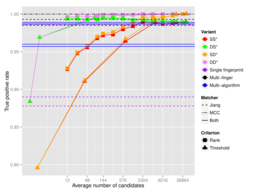 |
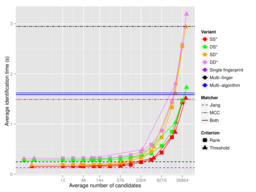 |
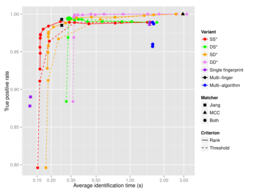 |
| CASIAv5 | 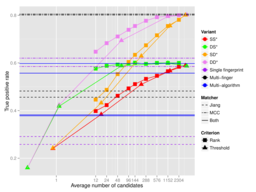 |
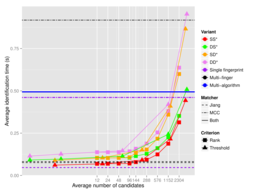 |
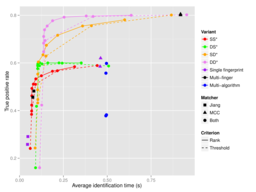 |
| MCYT100 | 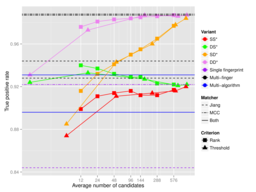 |
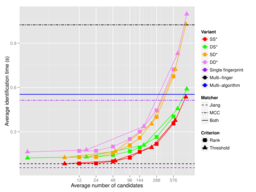 |
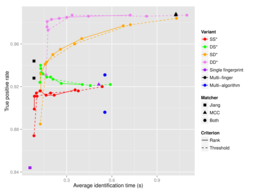 |
| FingerPass | 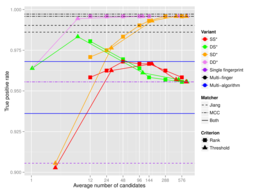 |
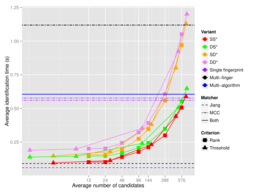 |
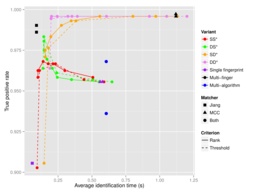 |
| DBSpain654 |  |
 |
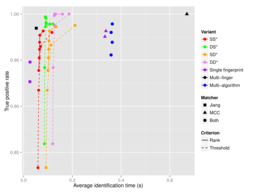 |
| DB25496 | 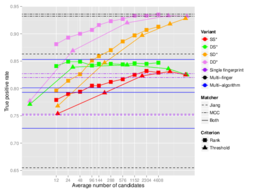 |
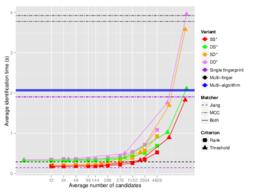 |
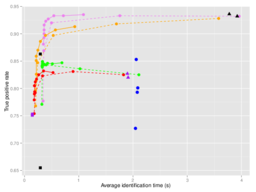 |
| NIST-DB14 | 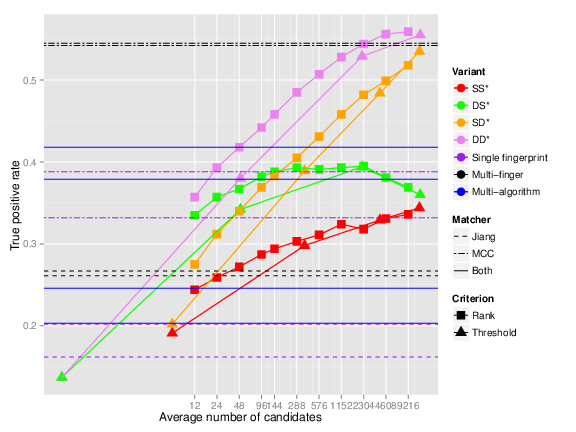 |
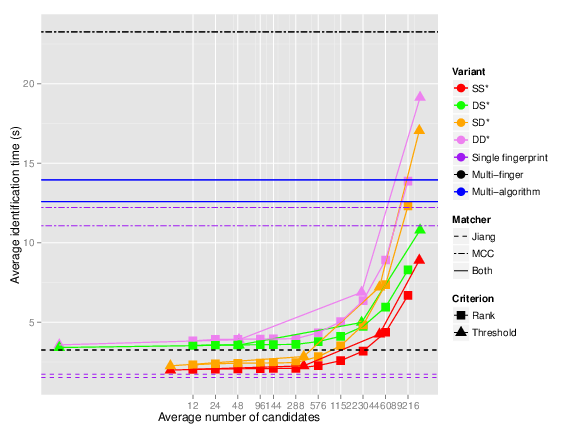 |
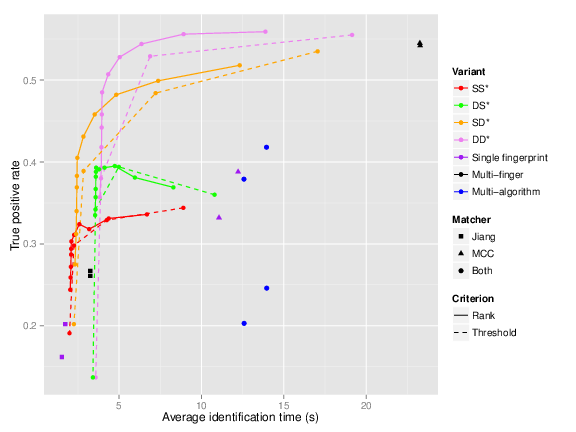 |
Table 2. Figures.
